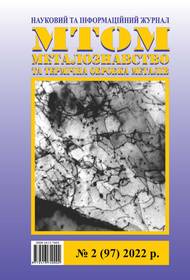Selection of heat treatment modes for pipes from alloy TI−3AL−2,5V FOR residual stresses removal at the final stage of production
DOI:
https://doi.org/10.30838/J.PMHTM.2413.050722.19.858Keywords:
titanium alloy Ti−3Al−2,5V, texture, residual stresses, heat treatmentAbstract
Purpose of research is to determine heat treatment modes at the final stage of titanium pipes manufacturing to remove residual stresses in accordance with the requirements of ASM standards before delivery of pipes in CWCR condition, after cold pressure treatment and heat treatment to remove residual stresses. Research methods: X-ray diffraction analysis for texture and inverse pole figures construction, evaluation of mechanical properties according to the ASTM standard and residual stresses by the Davydenkov method, as well as production of pipes, according to the developed modes in industrial conditions. Results. The residual stresses level at different heating temperatures of the pipes is evaluated. The mode of final heat treatment to remove residual stresses, which heating temperature in vacuum is 380…450 0C, depending on the previous degree of deformation was selected. Mechanical properties of pipes after rolling and subsequent heat treatment (CWCR state) are evaluated. The texture of the pipes mainly has a radial component and almost does not change during the final heat treatment to remove residual stresses. Practical value is to improve the technological process of titanium pipes production in industrial conditions and the quality of operation. Conclusions. The temperature range for removal of residual stresses, which is 380…450 0С, is set depending on preliminary deformation degree. The selected mode of heat treatment allows ensuring mechanical properties level in according to the requirements of AMS 4946. It is shown that heat treatment does not change the texture of the pipes, retaining more radial component, which provides relative compression ratios.

Downloads
Published
Issue
Section
License
Authors that are published in this journal agree to follow the conditions:
Authors reserve the right to the authorship of his work and cede the right to the journal of first publication of this work on conditions of the license under the Creative Commons Attribution License, which allows others to distribute it freely with the obligatory reference to the author of the original work and the first publication of the work in this journal.
